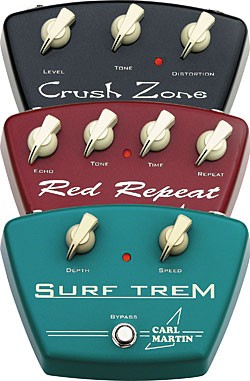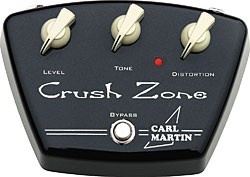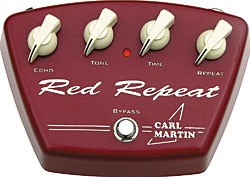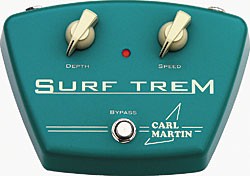
If you’re the type of hardcore gear geek who spends as much time evaluating guitarists based on what’s in their hands, rigs, and pedalboards as you do actually listening to what they’re playing, then you’ve probably noticed that a lot of pros these days are using Carl Martin pedals.
After hitting the scene with its first pedal in the early 1990s, the Carl Martin company started to make serious waves early in the 21st century with the Hot Drive ‘n Boost and Contour ‘n Boost pedals (reviewed in VG, December ’01). In early ’05, the company’s DeLayla XL and PlexiTone were launched to more rave reviews (VG, June ’05), and Carl Martin pedals were enjoying a reputation for being top-shelf in terms of construction and sound.
With its new Vintage Series pedals, the company is breaking new ground in regard to style and price while holding to its standards of quality and sound.

The three pedals in the series are the Crush Zone (a high-gain overdrive), Surf Trem (tremolo) and the Red Repeat (analog delay), all of which are manufactured not in Denmark, but in China. And while the words “made in China” have traditionally caused gearheads to recoil in disgust, these pedals suffer none of the low-quality, cookie cutter traits often associated with the tag. Rather, they boast Martin-designed (and tested) circuits and keystone-shaped heavy die-cast metal chassis with satin-finish paint and cream-colored stenciling, heavy-duty mechanical-bypass footswitches, easy-access 9-volt battery compartments, 9-volt power adaptor jacks, and cream-colored chickenhead knobs (the good ones, with the brass inserts).
A quick look inside one of the pedals reveals its Euro-style chassis mounted on a high-quality PC board that is wired very neatly, with 1⁄4″ input/output jacks, and chassis-mounted Alpha pots. Unlike so many imported pedals that use jacks and controls mounted directly to the circuit boards (and are thus prone to damage even if you do something as innocuous as stepping on one of the cords), the chassis-mounted components on the Carl Martin offer the promise of years of trouble-free functionality. We couldn’t find any deviations or shortcuts in design or components compared to Carl Martin’s standard pedal line, though they do lack an internal power supply.

Controls on the Vintage Series pedals are straightforward; the Crush Zone has controls for Level, Tone and Distortion; the Surf Trem has dials for Depth and Speed; and the Red Repeat lets you manipulate signal via controls for Echo, Tone, Time, and Repeat.
We had a listen to the Vintage Series using a Fender Custom Classic Telecaster running through a 1966 Fender Bandmaster with an open-back 2×12″ cabinet loaded with Tone Tubby speakers.
We began with the Surf Trem and were quickly pleased with the results. It proffered a lush ’50s-style tremolo effect with a smooth, deep “swish” and smooth waveform that really sounded great. Switching the pedal on and off several times revealed an exemplary purity of tone – very quiet, clean, and transparent. Comparing the Surf Trem to the Bandmaster’s own tremolo, we could dial them in to sound almost exactly the same; in fact, we’d give the Surf Trem the nod for its ability to produce a deeper effect, and its wider range of speed settings.
The Red Repeater also added no appreciable noise or coloration, just classic analog delay/echo with those slightly dirty, not-so-sterile repeats. Its Time control created anything from a super-short slap-back all the way to a 600-millisecond delay. The Tone control, which is essentially a high-cut, rolled off high-end on the repeats, allowing us to soften them so they didn’t get in the way of the dry signal, somewhat like the low-fidelity repeats from a tape echo. The only nit we have to pick with any of the Vintage Series is with the Red Repeater’s Time control – and it’s a common shortcoming on many units of this type; the lack of a label for the control’s milliseconds setting. Yes, it’s a minor thing, but it would help a user more accurately set delay times.

The Crush Zone produced a full-out high-gain distortion with definite midrange boost and aggressive overdrive. Even with its Distortion dialed out completely, the pedal distorts the signal enough to eliminate it from potential use as a boost. But it excels in the high-gain category with a pleasant, crunchy distortion that isn’t thin or brittle, even with the Tele bridge pickup. The Tone control is well-voiced, allowing for flavors ranging from bright and “spitty” to dark and creamy smooth. The only time we could coax any mush from it was if we jacked Distortion past 3 o’clock, and even then, the sound was more like a cool over-the-top super-high setting on a fuzz pedal.
This nifty-looking trio certainly lives up to the Carl Martin name in terms of pro-quality components, quiet operation, killer vintage tones, and a killer low price.
Carl Martin Vintage Series pedals
Price: $129 to $159 (retail).
Contact: Gary Castelluccio & Associates, phone (973) 772-3333; www.carlmartin.com.
This article originally appeared in VG‘s July 2006 issue. All copyrights are by the author and Vintage Guitar magazine. Unauthorized replication or use is strictly prohibited.
Carl Martin Crush Zone by Sledziuha


